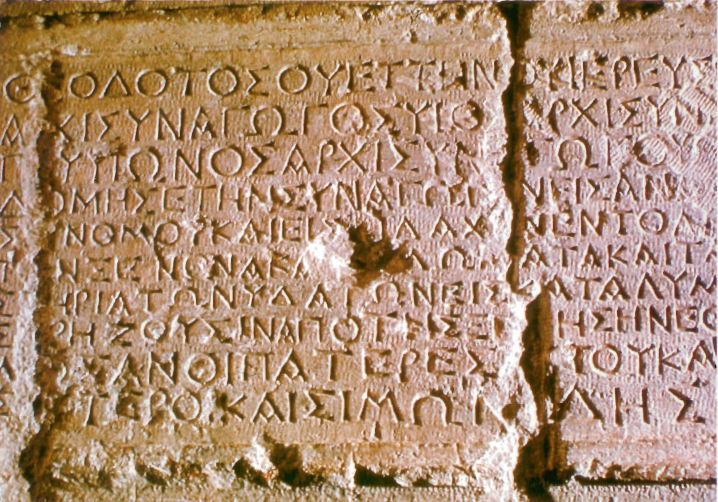Theodotus Inscription, 1st century CE
Herod the Great, who ruled under Roman tutelage, rebuilt the Temple Mount and embellished the Temple that stood at its center. The edifice was dedicated in 9 BCE and soon became famous as one of the most spectacular monuments of its time. Until it was destroyed in the year 70 CE, the Temple served as the focal point of Jewish worship. However, it was not the only religious building in the city. With its different Jewish sects and many pilgrims, Jerusalem also had hundreds of synagogues, in which prayers were held, study took place, festive meals were eaten, visitors from other parts of the country and from the Diaspora were accommodated, and judgments were delivered. The synagogue thus functioned similarly to the academy (beit midrasb) of later years.
In 66 CE, the Great Revolt erupted. Economic strains, social and religious tensions (among the Jews themselves and between Jews and the adherents of other religions), and, especially, oppression by the Roman authorities led the Jews to rise up against the occupying foreign power. The war lasted four years. The Romans defeated the Jewish strongholds one by one, though they, too, suffered significant losses. In the spring of the year 70 CE, they arrived at the gates of Jerusalem. Titus, commander of the Roman forces, besieged the city for many months, until his troops breached the last of its walls. The war ended, for all intents and purposes, in the summer, on the ninth of the month of Ab, with the destruction of the Temple.
Only one remnant has survived of the synagogues of pre-destruction Jerusalem – the Theodotus Inscription. It was discovered in 1913 in a cistern in the City of David, south of the Temple Mount. Inscribed in Greek on a square block of limestone, it came from a synagogue administered by a certain Theodotus, who bore the title “head of the synagogue.” It can be determined by the style of the inscription that the synagogue was built in the first century BCE and was thus contemporary with Herod’s Temple. It probably stood for about one hundred years before it was destroyed.
Along with the inscription, additional hewn stone blocks were found in the cistern. Their placement indicates that they had been deliberately deposited there. Perhaps one of the members of the congregation returned to the site after the destruction of Jerusalem and buried the remains of the building, hoping to reconstruct it someday.
Ornit Ilan, Image and Artifact- Treasures of the Rockefeller Museum with Aerial Photographs by Duby Tal and Moni Haramati. The Jerusalem Museum, 2000. p. 98.
See also-




